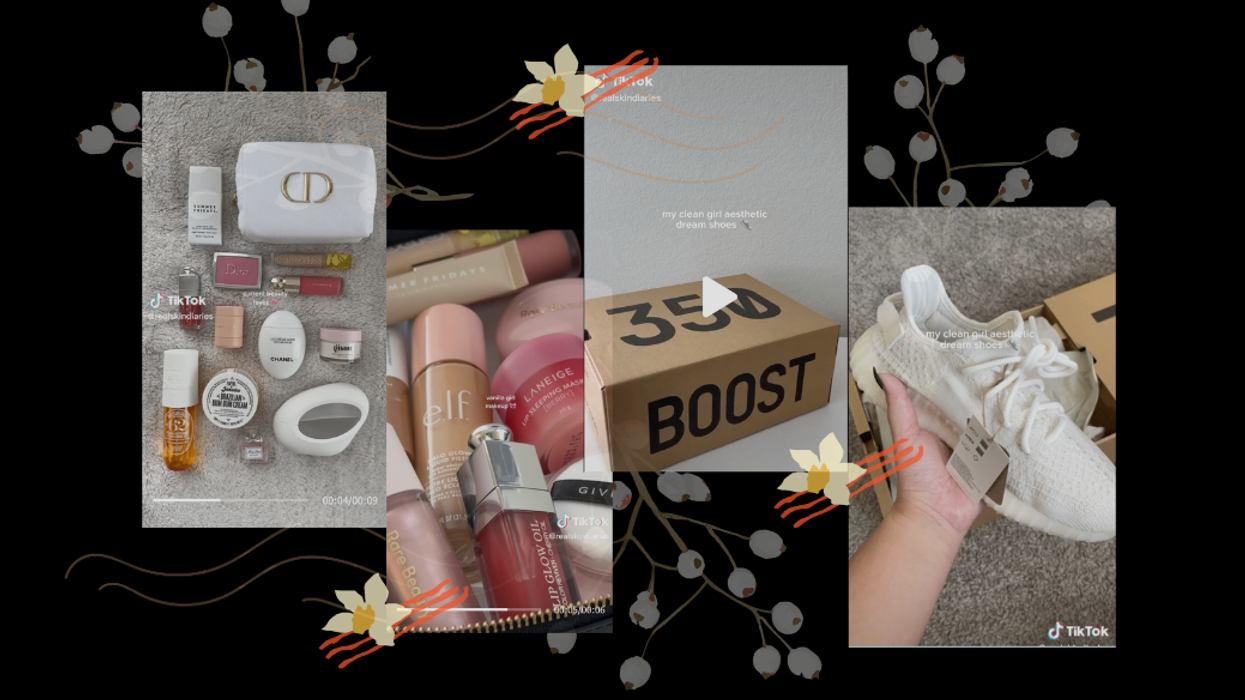Inside the Lucrative World of TikTok Microtrends
Kristin Snyder is dot.LA's 2022/23 Editorial Fellow. She previously interned with Tiger Oak Media and led the arts section for UCLA's Daily Bruin.

First came the e-girls, with their chunky hair highlights and fake freckles. Then came the cottagecore girls, with their poufy dresses and elaborate picnics. After them, people donned oversized, white button-down shirts to emulate “coastal grandmother” vibes. And most recently, the “Vanilla Girl” trend convinced folks to try soft sweaters and sweet perfumes to highlight cozy luxury. Sure, it’s easy to scoff at the ephemerality of all things TikTok. But that would be missing the myriad business opportunities that each of these niche, ever-evolving microtrends present for influencers.
Trazey Dutt is one such influencer who has used these trends to increase views. Her video showing off “Clean Girl aesthetic” shoes has 47,000 views alone. More importantly, Dutt has been using these microtrends to promote items via her Amazon storefront. Influencers in Amazon’s affiliate program can make up to 6% commission, depending on the product, when people use the links they provide in their videos.
With more users are turning to TikTok as a search engine, and using phrases like “Vanilla Girl” or “Coquette Girl” in captions and hashtags, microtrends allow influencers like Dutt to maintain an ever-replenishing ouevre of products to sell to their followers.
Here’s how it works:
Users who want to find more Vanilla Girl recommendations will search the phrase on TikTok. Numerous videos will serve them lists of products, including candles, vanilla-scented perfumes and claw clips, that fit the vibe. Dutt then uses the hashtag in her most recent video featuring her favorite beauty products in order to reach a wider audience.
“I also use [these trends] for keywords because now people are using them as search terms,” Dutt says.
In fact, the combined impact of the e-girl and cottagecore trends, both of which encouraged people to pile on pink blush, led to a 39% increase in blush sales in 2021. And one more or less unknown fashion brand, Selkie, was launched into virality after cottagecore-minded individuals sold out its Puff Dress.
But not everyone is so keen on using microtrends to grow their following and their business.
“I really do feel like it's literally just propagating fast fashion,” says TikTok influencer Aisha Toulegenova. “It’s just a complete waste.”
To her credit, TikTok has long been accused of promoting overconsumption and fast fashion. Clothing companies do churn out items based on these trends—in response to TikTok’s Dark Academia trend, which features sweater vests and oversized trousers, fast fashion company Cider delivered this social media-inspired aesthetic on its website. More recently, Urban Outfitters launched a balletcore-inspired clothing line after ballet flats and leg warmers went viral on TikTok.
But the real engine behind these trends is the TikTok haul videos. In them, users will unbox and try on large amounts of clothing and accessories that fit these specific aesthetics. Fast fashion company Shein hauls in particular are notorious for going viral and bringing in more viewers. Making purchases to fit these trends can boost their popularity, as a video that features long skirts and crystal chains that can easily be categorized as both goblincore and fairy grunge—two microtrends that proliferated last year.
Often too, these trends are often almost indistinguishable, Toulegenova says. She cites the fact that Vanilla Girl is hardly different from Clean Girl aesthetic. Both emphasize neutral tones, comfortable fabrics and simple accessories. But the introduction of Vanilla Girl lets influencers make new videos to promote new products. At times, the items are even the same: For example, a classic, cable-knit white sweater can be categorized as both Vanilla Girl and Clean Girl. But with the addition of an entirely new label, the microtrend inspires people to go make new purchases despite the fact they likely already own products that could match either aesthetic.
These trends, according to Toulegenova, simply “re-ignite themselves in different names just because it is easy to package a video, sell products and label them.”
- What’s Behind the ‘Architectural Digest’ Decor at LA’s Ketamine Clinics? ›
- PR Firm Carter Agency Allegedly Scammed Hundreds of Influencers Out of Brand Deals ›
- More and More Influencers Are Launching Their Own VC Funds — Here’s Why ›
- TikTok Is Breaking the Traditional Digital Agency. Here’s How. ›
- The Glassdoor for Influencers: FYPM - dot.LA ›
Kristin Snyder is dot.LA's 2022/23 Editorial Fellow. She previously interned with Tiger Oak Media and led the arts section for UCLA's Daily Bruin.




